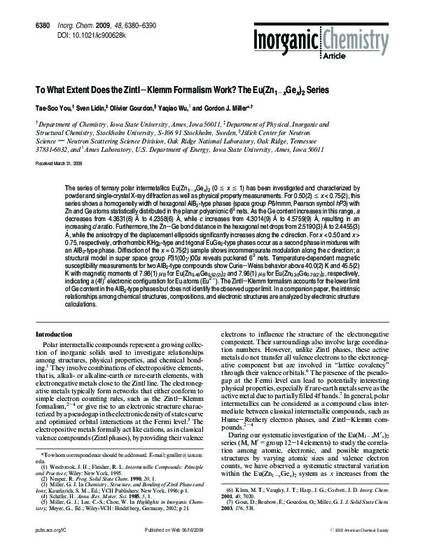
The series of ternary polar intermetallics Eu(Zn1−xGex)2 (0 ≤ x ≤ 1) has been investigated and characterized by powder and single-crystal X-ray diffraction as well as physical property measurements. For 0.50(2) ≤ x < 0.75(2), this series shows a homogeneity width of hexagonal AlB2-type phases (space group P6/mmm, Pearson symbol hP3) with Zn and Ge atoms statistically distributed in the planar polyanionic 63 nets. As the Ge content increases in this range, a decreases from 4.3631(6) Å to 4.2358(6) Å, while c increases from 4.3014(9) Å to 4.5759(9) Å, resulting in an increasing c/a ratio. Furthermore, the Zn−Ge bond distance in the hexagonal net drops from 2.5190(3) Å to 2.4455(3) Å, while the anisotropy of the displacement ellipsoids significantly increases along the c direction. For x < 0.50 and x > 0.75, respectively, orthorhombic KHg2-type and trigonal EuGe2-type phases occur as a second phase in mixtures with an AlB2-type phase. Diffraction of the x = 0.75(2) sample shows incommensurate modulation along the c direction; a structural model in super space group P3m̅1(00γ)00s reveals puckered 63 nets. Temperature-dependent magnetic susceptibility measurements for two AlB2-type compounds show Curie−Weiss behavior above 40.0(2) K and 45.5(2) K with magnetic moments of 7.98(1) μB for Eu(Zn0.48Ge0.52(2))2 and 7.96(1) μB for Eu(Zn0.30Ge0.70(2))2, respectively, indicating a (4f)7 electronic configuration for Eu atoms (Eu2+). The Zintl−Klemm formalism accounts for the lower limit of Ge content in the AlB2-type phases but does not identify the observed upper limit. In a companion paper, the intrinsic relationships among chemical structures, compositions, and electronic structures are analyzed by electronic structure calculations.
Available at: http://works.bepress.com/gordon-miller/109/

Reprinted (adapted) with permission from Inorg. Chem., 2009, 48 (14), pp 6380–6390. Copyright 2009 American Chemical Society.